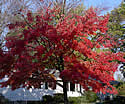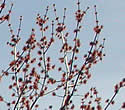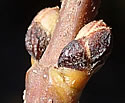Acer rubrum (Red Maple)
| Also known as: | |
|---|---|
| Genus: | Acer |
| Family: | Sapindaceae (Soapberry) |
| Life cycle: | perennial woody |
| Origin: | native |
| Habitat: | part shade, sun; along shores, hardwood swamps |
| Bloom season: | April - May |
| Plant height: | 50 to 95 feet |
| Wetland Indicator Status: | GP: FAC MW: FAC NCNE: FAC |
| MN county distribution (click map to enlarge): |  |
| National distribution (click map to enlarge): |  |
Pick an image for a larger view. See the glossary for icon descriptions.
Detailed Information
Flower: 


![[photo of male flowers]](/udata/r9ndp23q/pd3/acer-rubrum-789-9-t.jpg) Compact, spreading, ½ to ¾-inch clusters on short lateral branches at tips of 1 year old branches, a cluster consisting of 2 to 6 flowers and appearing before the leaves emerge in spring. Male and female flowers typically occur on separate trees, but can be on separate branches on the same tree. Occasionally flowers are perfect (have both male and female parts). Male flowers are pink to red, rarely yellow, have 5 sepals, 5 petals, and 5 to 10 slender, spreading stamens that are 2 or 3 times longer than the sepals.
Compact, spreading, ½ to ¾-inch clusters on short lateral branches at tips of 1 year old branches, a cluster consisting of 2 to 6 flowers and appearing before the leaves emerge in spring. Male and female flowers typically occur on separate trees, but can be on separate branches on the same tree. Occasionally flowers are perfect (have both male and female parts). Male flowers are pink to red, rarely yellow, have 5 sepals, 5 petals, and 5 to 10 slender, spreading stamens that are 2 or 3 times longer than the sepals.
![[photo of female flowers]](/udata/r9ndp23q/pd3/acer-rubrum-8937-1-t.jpg) Females are in similar sized clusters, the flowers with two bright red arching styles in the center. The flower stalk elongates up to 2 inches long, eventually forming a drooping cluster.
Females are in similar sized clusters, the flowers with two bright red arching styles in the center. The flower stalk elongates up to 2 inches long, eventually forming a drooping cluster.
Leaves and bark: 


![[photo of leaves]](/udata/r9ndp23q/pd3/acer-rubrum-783-2e-t.jpg) Leaves are simple and opposite, long stalked, the blade up to 5½ inches long and wide but typically smaller, with 3 to 5 lobes, the central and two upper laterals forming distinctive pointed lobes with the two basal lobes greatly reduced or nearly absent. The central lobe is distinctively squarish below the pointed tip, the sides parallel or nearly so. 5 distinct palmate veins radiate from the stalk.
Leaves are simple and opposite, long stalked, the blade up to 5½ inches long and wide but typically smaller, with 3 to 5 lobes, the central and two upper laterals forming distinctive pointed lobes with the two basal lobes greatly reduced or nearly absent. The central lobe is distinctively squarish below the pointed tip, the sides parallel or nearly so. 5 distinct palmate veins radiate from the stalk.
![[photo of hairy leaf underside]](/udata/r9ndp23q/pd3/acer-rubrum-783-4-t.jpg) The upper surface is dark green and smooth, the lower surface much paler with short hairs along the veins and patches in the vein axils. Edges are sharply toothed with 25 or more teeth per side. Leaves turn red in fall.
The upper surface is dark green and smooth, the lower surface much paler with short hairs along the veins and patches in the vein axils. Edges are sharply toothed with 25 or more teeth per side. Leaves turn red in fall.
![[photo of trunk]](/udata/r9ndp23q/pd3/acer-rubrum-985983-t.jpg) One year old twigs are smooth, brown to reddish, especially right before spring bud break, turning silvery gray like the branches in the second year. Older branches and trunk become darker and furrowed with age. The trunk can grow to 25 inches in diameter at breast height (dbh).
One year old twigs are smooth, brown to reddish, especially right before spring bud break, turning silvery gray like the branches in the second year. Older branches and trunk become darker and furrowed with age. The trunk can grow to 25 inches in diameter at breast height (dbh).
Fruit: 
![[photo of fruit]](/udata/r9ndp23q/pd3/acer-rubrum-827-4-t.jpg) Fruit is a pair of winged seeds (samara), 2/3 to 1 inch long that mature and shed in early summer. The wings form an angle between 45 and 90 degrees.
Fruit is a pair of winged seeds (samara), 2/3 to 1 inch long that mature and shed in early summer. The wings form an angle between 45 and 90 degrees.
Notes:
Red Maple occurs commonly in moist habitats throughout Minnesota's central and northeastern forests and its frequency on more upland sites has likely increased due to fire suppression post European settlement. It has also become a relatively common urban tree with horticultural cultivars of male trees selected for both shape and fall color. These cultivars are universally male selections to avoid a seed crop but also contribute to high pollen counts during flowering. Unfortunately, uniformed consumers (or unscrupulous installers) too often place these trees into too compacted or dry sites where they perform poorly. Its common name most likely comes from its bright red flower clusters and red twigs, and perhaps in part from its spectacular fall color that leans towards deep scarlet and into maroons and pinks. It can easily be distinguished from the colorful Sugar Maple (A. saccharum) by its red flower twigs that contrast against its silvery branches and can be discerned from a great distance in early spring, plus Red Maple has finely toothed leaf edges whereas Sugar Maple is smooth between the points. Red Maple may also be confused with Freeman Maple (A. x freemanii), a natural hybrid between Red and Silver Maple selected as horticultural cultivars, and now widely planted in urban areas. Unlike the squarish central leaf lobe of Red Maple, the central leaf lobe on Freeman Maple is more wedge-shaped, narrower at the sinus before it widens towards the tip, the sides often concave rather than straight like Red Maple.
Native Plant Nurseries, Restoration and Landscaping Services ↓
More photos
 Red Maple tree in fall color
Red Maple tree in fall color branches flowering in spring
branches flowering in spring flower buds and red twig
flower buds and red twig leaf buds and brown twig
leaf buds and brown twig leaf variation
leaf variation a line of Red Maple in spring
a line of Red Maple in spring
Photos courtesy Peter M. Dziuk taken in Aitkin, Anoka, Goodhue, Lake and Ramsey counties.
Comments
Have you seen this plant in Minnesota, or have any other comments about it?






